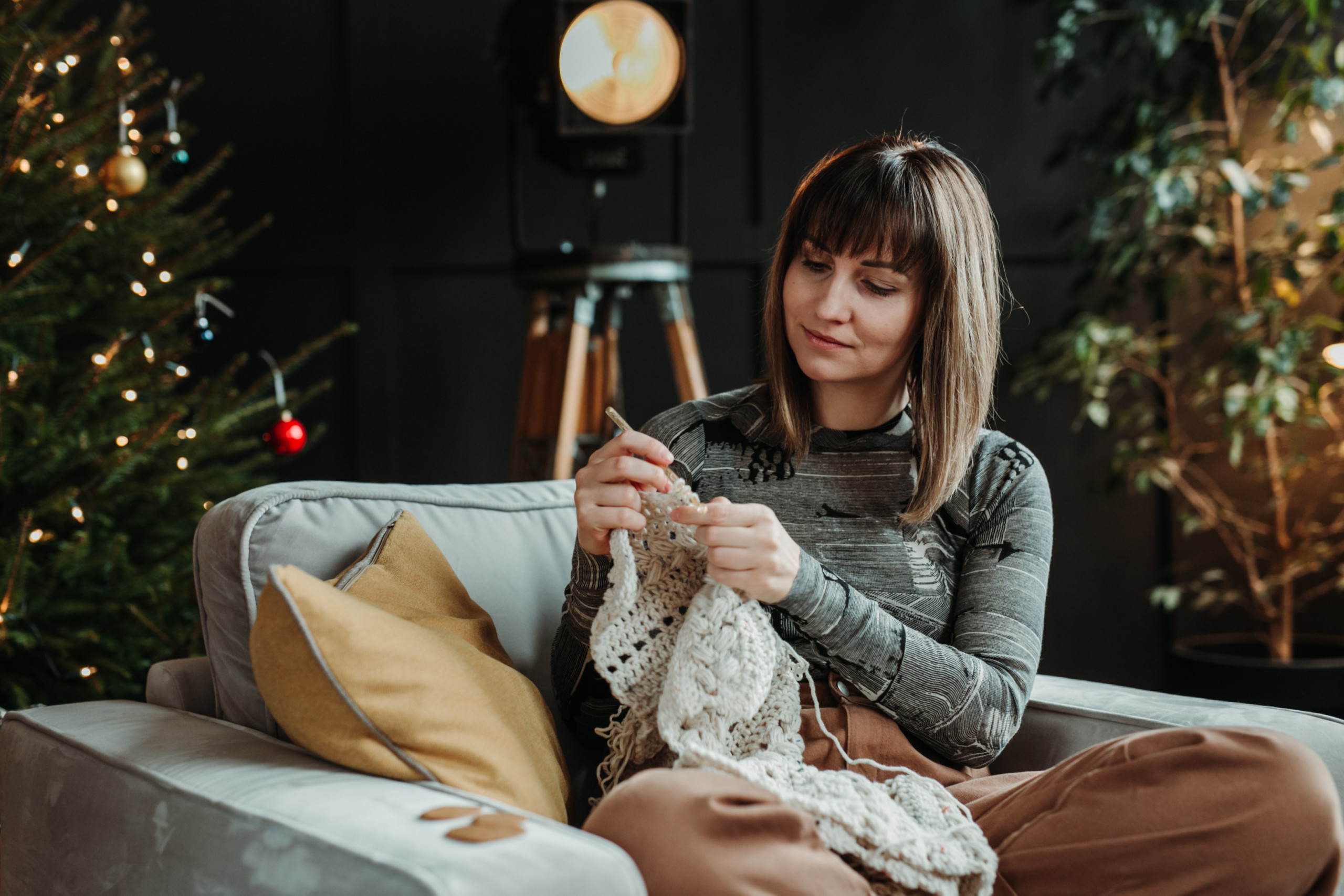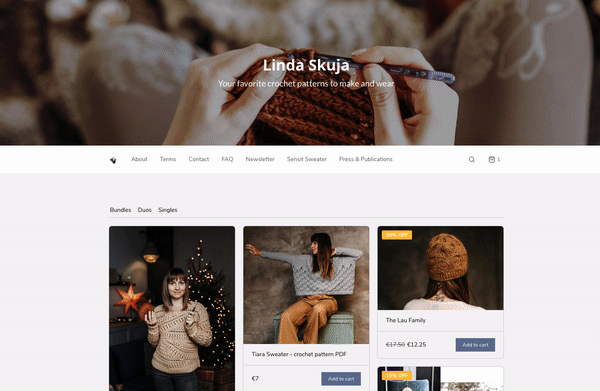From self-taught hobbyist to award-winning textile designer: how Linda built a profitable crochet pattern business

Linda is an award-winning Latvian textile designer and talented solopreneur who has been in the crochet business for over a decade. Her stylish designs have been published in major magazines and books of the crochet industry, and she has worked with fashion designers all over the world. She even designed samples for New York fashion week!
She first picked up crocheting as a creative hobby and learned everything she could from magazines. Linda’s passion and patience for learning the craft led her to achieve international recognition and, eventually, build her own business.
Now, she happily designs for her own brand @elevenhandmade and, every now and then, publishes her patterns in magazines. She also shares her knowledge as a mentor, and nurtures a growing following of 67.1K on Instagram.
Linda chose Sellfy for its ease of use and focus on digital products. In this interview, she offers great tips for growing your Instagram profile, so read on to learn more about that and other useful insights from Linda’s journey.
How do you define yourself as a creator and entrepreneur?
I’m a textile designer from Latvia who designs garments and sells crochet patterns. I would also say that I’m a solopreneur since I do everything by myself.
How did you learn textile design?
It started out as a hobby at first. I didn’t have an educational background in textile design, so I learned absolutely everything on my own.
I did get the education later on, but in the beginning, I didn’t even know how to make a pattern, so I learned about things like stitches from different magazines. It was like discovering a whole new world.

When did you get the idea to turn your hobby into a crochet business?
I first got the idea in 2010 when I was trying out different jobs like furniture design. I had always known that I wanted to do something creative in my career, so I started sharing my crochet patterns online. I didn’t really think of my first designs as products at the time. I was just writing down the patterns I liked without thinking about the user experience.
Then, a year later, I won the 2011 Best New Designer Prize—my first big milestone. And, that was when I realized I should turn it into a business.
The time and effort it took to write down all the patterns also made me realize that I could start selling them. In fact, some of my patterns from 2011 are still bringing in sales!
How did you come across Sellfy and why did you choose our platform?
I wanted my eCommerce platform to be a personal website as well as an online store. I had used several platforms before, but those were more like blogs than stores. So, when Maris, the CEO of Sellfy, told me about the platform, I realized that I could finally have a homepage with a store. Back then, Sellfy had a strong focus on digital products, which was exactly what I needed.
Now, fast-forward to today, and Sellfy has expanded enormously—from digital goods to subscriptions, physical items, print on demand, and more. I feel like my business is in good hands with Sellfy.
What type of platform ultimately works better: an eCommerce store or a blog? What’s your experience?
I think that depends on the purpose of your webpage and the target audience. If it’s just for, let’s say, publishing houses or editors who want to read about you and see your portfolio, they probably wouldn’t care about an online store. But, if it’s for interested customers, then a store would make more sense.
So, I can’t really say what works better, but I do think that an all-in-one solution is probably the best.
My personal experience with other platforms is that they tend to be more complex. For example, putting up product listings was so hard that I had to look up answers in the help center.
With Sellfy, everything is smooth. It only took 30 minutes to set up my listings.

What are the top three Sellfy features you like the most?
I really like the easy and user-friendly checkout process—it’s literally just two clicks and it’s done. I also like that Sellfy’s customer support is always available because, sometimes, there are people who have questions or can’t download their files.
Another cool Sellfy feature is email marketing which allows me to notify my customers about product file updates.
How has Sellfy impacted your life and business?
I love that I have a beautiful storefront now that represents my brand, and that I can use my Sellfy site to pitch new collaborations with magazines and publishing houses. I’ve received great feedback about my site from both editors and customers.
I’ve also noticed that the magazines that want to interview me usually get my information from my Sellfy page, which is nice.
Overall, I’m very happy with Sellfy and I like that I’m in control of everything on the platform.
What are the most challenging aspects of having a crochet business and being a solopreneur?
I’d say that it’s always a little challenging for me as the main market is in the US, which has its own twists and quirks. So, there’s always extra paperwork when I submit my designs to magazines overseas. I also have to make sure that I finish my designs earlier because of the shipping time. And, now, due to the social changes that the pandemic has brought, it’s even harder.
And, then there’s the social aspect of the crochet community—the majority of the people are Northern Americans. And, they have their own way of doing things and solving issues. Sometimes, I’m not sure how to act or what to say because I don’t really know the rules of the game and it’s hard for me. As a Latvian, it can be difficult to know my place in all of that.
Another challenging aspect for me would be accounting. While I do have a good accountant, I still need to gather information and do paperwork.
And, since I’m a solopreneur who has to do it all, I don’t always get enough time for everything. But, it’s also just a matter of setting clear priorities for myself.
And, what’s your favorite part of the business?
I think my favorite part is the moment I release a new pattern, create promo codes with Sellfy, and send out a newsletter. I can just sit back and relax and watch the sales come in!
What made you pick the US market?
I chose the US because it’s one of the biggest English-speaking markets in the world, and I knew that I wanted to reach an international audience.
There are also other markets like the UK, Australia, New Zealand, and Canada, but crochet is a multi-billion dollar industry in the US.
Let’s talk about social media. How did you grow your Instagram following?
I had been in the crochet pattern business for about six years when I temporarily switched to a different type of business, and then switched back again in 2017. In the same year, I created my Instagram account and started posting every day, even during pregnancy and the postpartum period. My first posts were pictures taken with my phone or some of my designs from magazines.
My Instagram feed wasn’t that great at the beginning, so I partnered with a photographer to create some stunning content. I also focused on selling points and what my followers wanted to see.
I was so consistent with my posts that, at some point, burnout set in and I stopped for a couple of months. But, I think I’ve found a good balance now by posting just two or three times per week. It works quite well for me.
The initial growth was very slow, though. I didn’t hit a turning point until a major crafting site discovered me and I shared a post with their followers. From that post alone, I got several thousand followers in a day. That was great, and I think that was when it really started growing for me.

Do you have any special Instagram tips and tricks, or rules?
I don’t have any specific rules, but I always try to add a call-to-action and, of course, hashtags. I think it’s also important to keep in mind that there are always going to be new people discovering your profile, so it’s a good idea to reintroduce yourself sometimes.
Another thing I do is answer people’s questions, talk about my day and what I’m currently working on. And, then I make sure to celebrate the completed projects of followers who have used my patterns.
In other words, I offer the type of content that I would personally like to see from a creator.
Do you use any other platforms or social media channels besides Instagram?
I use Facebook a little, but only like once a month. Aside from Facebook, I don’t really use any other social media channels except for maybe Pinterest. I don’t personally promote myself on Pinterest, but there are people who like my work and pin my designs, so I get some traffic from there.
The only other platforms I use are Etsy for its search engine and niche audience, and then Ravelry since it’s a big networking site for knitters and crocheters.
Tell me about your marketing strategies. How do you convert followers into buyers?
To be honest, I never really think about doing promotions or marketing. I just keep working on making new stuff and getting published. But, I usually make a post when I have a new publication or product, or when I’m teaming up with another designer. And, sometimes, I also give out discounts to loyal customers.
To convert followers into buyers, I give them encouragement and support by offering resources and learning materials.
I also answer their questions and try to find out what’s holding them back from trying out my patterns. I make sure to include all the necessary information and instructions in my products.
What advice would you give to other solopreneurs or textile designers who want to start a business?
I’d say just do it! You need to put yourself out there so people can find you. That’s how I got to design for New York Fashion Week—I just put my stuff on Etsy and then someone found my work and liked it.
Just start building your site and online presence, and uploading your products one step at a time. You can always make edits and improvements later on—it’s a constant work in progress.
Also, remember that you don’t have to be perfect when it comes to social media—you just need to be present and consistent. And, last but not least, don’t compare yourself with someone who has done it far longer than you. Comparison is a trap.
Success stories






